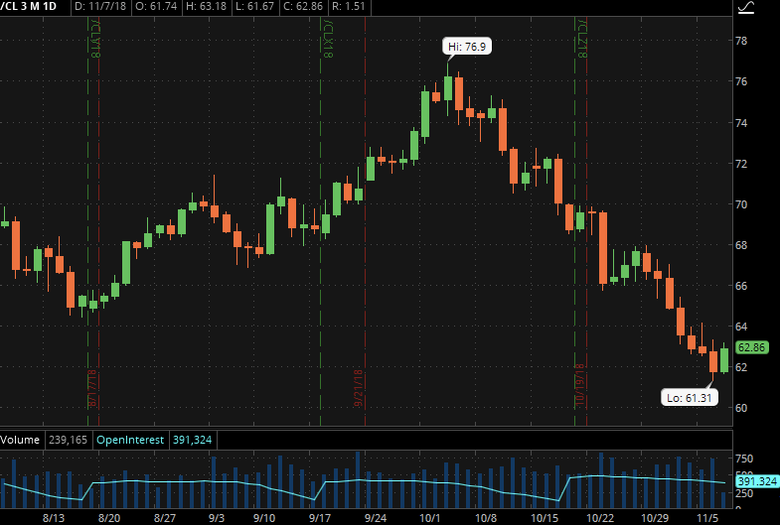(Wednesday Market Open) With Election Day 2018 now in the rear-view mirror and results in line with expectations, it seems that Wall Street may breathe a little easier as one source of recent volatility has been removed.
The elections had arguably created an overhang of uncertainty that added its shadow to other variables such as rising interest rates in the United States, politics in Europe, and U.S.-China trade negotiations and their potential to affect global economic growth.
Those other factors still remain, and perhaps they could cause volatility to continue, but the tension is arguably lessened now that we have election results in hand, instead of just uncertainty about the elections. The CBOE Volatility Index (VIX) began today’s session down about 12%, briefly dipping into the 16-handle for the first time since early October. Lessened expected volatility and moves higher in equity index futures this morning seem to be coming as investors appear pleased that the election results were in line with what the market was expecting.
Going forward, it seems likely that investors could return their focus to the apparent revaluation of equities that helped spark sharp selling last month as Treasury yields rose.
Gridlock Historically Not Bad For Market
Some of the political issues that Wall Street has apparently had its eye on include prescription drug prices, bank regulation, and spending on infrastructure. It remains to be seen whether new legislation touching on these issues will be passed, or if Washington gridlock will keep things from moving forward. Tech companies could do well, as a divided Congress could forestall any attempts by the administration to pursue potential antitrust violations by big tech. But it’s possible that pharmaceutical companies could come under pressure if there is a continued focus on lowering drug prices.
Even if there is gridlock, stocks have historically performed well in split governments. As CNBC reported, the S&P 500 has gained an average of 12 percent under a divided congress with a Republican president.
Volumes were light for trading of stocks on the three main U.S. indices on Tuesday. It seems that investors and traders spent some time out of the office and at the polls, and market participants probably didn’t want to put on any big new positions in case the elections resulted in a big surprise.
Light volumes can exacerbate moves either to the upside or downside. So it’s notable that the sentiment was positive on Tuesday, with all of the S&P 500’s 11 sectors ending in the green. While it remains to be seen whether the market has put in a bottom after recent selling, the bias to the upside on a relatively quiet day seems to be encouraging.
Oil’s Slide
Even the energy sector, which was the worst performer of the day, managed a gain despite pressure on oil prices.
The Trump administration’s waivers exempting some buyers of Iranian oil from sanctions seem to have eased tensions that had previously lifted oil prices. There also seem to be concerns about a potential easing of global economic growth denting oil demand.
Crude prices have seen a bounce this morning, but in the longer term, if the trade dispute between the United States and China does meaningfully curtail global economic growth, that could mean lower demand for oil.

Figure 1: Oil prices have been moving lower, with recent pressure coming after the Trump administration granted waivers to some buyers of Iranian oil. Data Source: CME Group (NASDAQ:CME). Chart source: The thinkorswim® platform from TD Ameritrade.For illustrative purposes only. Past performance does not guarantee future results.
Strength in Consumer Credit: Outstanding consumer credit has been on the rise and, based on a Briefing.com consensus, expectations are for the latest reading to show another gain. Later this afternoon, the Federal Reserve is scheduled to publish its monthly report on the subject, with a Breifing.com consensus showing expectations of a rise of $14.5 billion in September. Last month’s report, which showed total outstanding consumer credit rose $20.1 billion in August, reflected “a pickup in credit demand that should be construed as an offshoot of a strengthening economy led by a solid labor market,” Briefing.com said.
Producer Prices: This week is relatively light on economic data reports. But investors are scheduled to get an important reading on the inflation situation on Friday in the form of the producer price index from the Bureau of Labor Statistics. The October headline figure is expected to increase by 0.2%, according to a Briefing.com consensus. If the number comes in as expected, that would be the same increase as the prior month and may not alter the Fed’s course of gradually raising interest rates. As of early Wednesday, the futures market was showing a better than 80% chance of at least a 25-basis-point rate hike before year-end. Investors may want to consider watching the futures market after the producer price report comes out Friday morning to see if expectations for a December rate hike increase or decrease.
Novembers to Remember: There’s a longstanding adage on Wall Street that says, “Sell in May and go away.” But assuming you consider following this adage (and there's plenty of data on both sides of the stock market “seasonality” argument), when should you think about coming back? If history is any indication, November might be a pretty good time. Average rolling six-month S&P 500 price returns from the end of 1945 through the end of last month show that the index posted an average gain of 6.6% during the November-April period but only a 1.4% return from May through October, according to investment research firm CFRA. The lower-performing period may show more weakness because of reduced capital inflows, investor vacations, Q3 earnings and fiscal year-end for mutual funds, CFRA said. The strength in the stronger-performing period might be helped by increased cash infusions at the beginning of the calendar year from pension funds, bonuses, 401(k) contributions, IRAs, and tax refunds, the research firm said. “The S&P 500 has traditionally entered November at a fairly low price point when compared with other months,” CFRA said. “November is also around the time that analysts begin looking toward next year’s earnings estimates, or five quarters ahead, rather than focusing on the final one of the current year. As a result, optimism improves, causing the cycle to start all over again.”
TD Ameritrade® commentary for educational purposes only. Member SIPC. Options involve risks and are not suitable for all investors. Please read Characteristics and Risks of Standardized Options.
